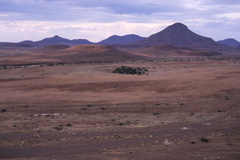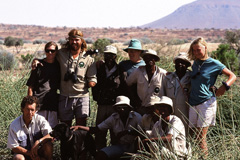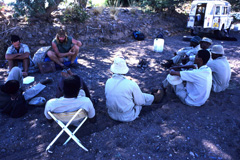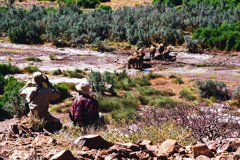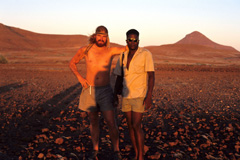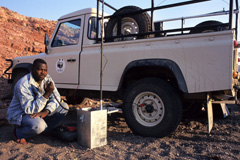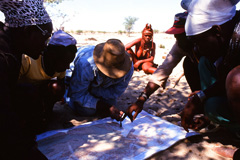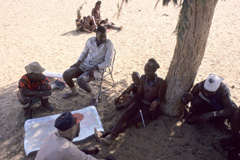Dr. Stephan Getzin | Scientist | Ecologist
Stephan Getzin – Information about me
Already as a child, I was fascinated by Africa with its diverse life and magnificent landscapes, which is why the continent always influenced my life and career. As a natural scientist, I am specialized today in various fields of research such as dryland ecology and the spatial analysis of plant and animal patterns. I am particularly interested in how plants and animals organize themselves together to cope better with water scarcity. In Namibia and Australia, I am undertaking active research on fairy circles, plant rings and other vegetation patterns. I am member of the University of Goettingen in Germany and associate member of the Gobabeb Namib Research Institute in Namibia.
First studies and first contact with Fairy Circles
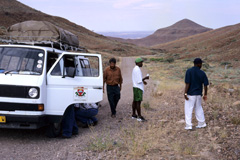 I studied ecology and geography at the University of Namibia - UNAM and graduated in 2000 as the first full-time student from Germany with a B.Sc. With my B.Sc. thesis, I focused on grass species diversity and grazing gradients in the Daan Viljoen Game Park, employing various types of multivariate statistics. During my studies, we made several excursions such as to Gobabeb, the Atlantic Coast or the Damaraland. By that time, I was also a volunteer with the communal game guard project in Namibia’s Kaokoveld and Damaraland, today’s Kunene. The project is called Integrated Rural Development and Nature Conservation (IRDNC). The aim of this project is to specifically protect wildlife outside of traditional national park boundaries. The IRDNC project and its founder, Garth Owen-Smith, won many of the highest environmental awards, such as the Goldman Environmental Prize for Africa or the UN’s Environmental Program Global 500 Award. It has become one of the most successful nature conservation projects on the African continent because it pursues a holistic approach in which the rural population is given back their old hunting rights and women are actively involved in the decision-making processes.
I studied ecology and geography at the University of Namibia - UNAM and graduated in 2000 as the first full-time student from Germany with a B.Sc. With my B.Sc. thesis, I focused on grass species diversity and grazing gradients in the Daan Viljoen Game Park, employing various types of multivariate statistics. During my studies, we made several excursions such as to Gobabeb, the Atlantic Coast or the Damaraland. By that time, I was also a volunteer with the communal game guard project in Namibia’s Kaokoveld and Damaraland, today’s Kunene. The project is called Integrated Rural Development and Nature Conservation (IRDNC). The aim of this project is to specifically protect wildlife outside of traditional national park boundaries. The IRDNC project and its founder, Garth Owen-Smith, won many of the highest environmental awards, such as the Goldman Environmental Prize for Africa or the UN’s Environmental Program Global 500 Award. It has become one of the most successful nature conservation projects on the African continent because it pursues a holistic approach in which the rural population is given back their old hunting rights and women are actively involved in the decision-making processes.
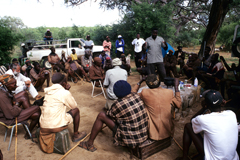 I accompanied John Kasaona – the current director of the project – on various tours to the Kaokoveld, where, for example, the border lines of the new conservancy in the Marienfluss or Hartmann’s Valley were negotiated with the local Himba chiefs. It was these tours within the framework of the IRDNC project in the remote north-west of Namibia that finally led me to the fairy circles in 1999. At the beginning of 2000 I undertook an expedition to the Kaokoveld together with Thorsten Becker, which led to the first publication on “fairy circles”, which established this name in a research article. Until today, more than 100 articles can be found on the topic “fairy circles” in the Web of Science. Since then, I am also closely following the research developments on that topic as an author and reviewer.
I accompanied John Kasaona – the current director of the project – on various tours to the Kaokoveld, where, for example, the border lines of the new conservancy in the Marienfluss or Hartmann’s Valley were negotiated with the local Himba chiefs. It was these tours within the framework of the IRDNC project in the remote north-west of Namibia that finally led me to the fairy circles in 1999. At the beginning of 2000 I undertook an expedition to the Kaokoveld together with Thorsten Becker, which led to the first publication on “fairy circles”, which established this name in a research article. Until today, more than 100 articles can be found on the topic “fairy circles” in the Web of Science. Since then, I am also closely following the research developments on that topic as an author and reviewer.
Further research career until today
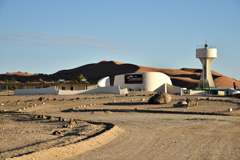 In 2002 I did my M.Sc. about “Structural Fire Effects in the World's Savannas” at the University of Potsdam in Germany. From 2003 to 2007 I completed my doctorate about spatial ecology in forests at the University of Jena. During that time, I specialized in spatial statistics and also spent a few months at the University of Alberta in Canada, analyzing spatial forest data on Vancouver Island. Spatial ecology investigates, in particular, the spatial positions of objects such as trees, shrubs, grass tussocks, fairy circles, plant rings, termite mounds or the location of bird nests. Using such a bird's-eye view and spatially-explicit statistics, one can learn a lot about the specific spatial patterns of the objects and the past processes that have caused these patterns. Between 2008 and 2010 I was carrying out my first post-doc project using such methods for forest applications in Germany, including novel drone technology.
In 2002 I did my M.Sc. about “Structural Fire Effects in the World's Savannas” at the University of Potsdam in Germany. From 2003 to 2007 I completed my doctorate about spatial ecology in forests at the University of Jena. During that time, I specialized in spatial statistics and also spent a few months at the University of Alberta in Canada, analyzing spatial forest data on Vancouver Island. Spatial ecology investigates, in particular, the spatial positions of objects such as trees, shrubs, grass tussocks, fairy circles, plant rings, termite mounds or the location of bird nests. Using such a bird's-eye view and spatially-explicit statistics, one can learn a lot about the specific spatial patterns of the objects and the past processes that have caused these patterns. Between 2008 and 2010 I was carrying out my first post-doc project using such methods for forest applications in Germany, including novel drone technology.
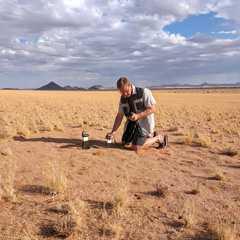 By that time, we used prototype drones and undertook worldwide one of the first vegetation surveys to analyze the forest structure with such drones. Between 2011 and 2016 I was a post-doc in the research project SPATIODIVERSITY at the Helmholtz Centre for Environmental Research, which investigated the tropical forest diversity around the globe using spatial statistics. In 2014 I started working with a novel drone that had a laser scanner, a multi-spectral camera, a thermal and a normal photo camera. Using this drone, I undertook in 2017 a large survey on our discovered fairy circles in Western Australia. Since 2020 I am employing mainly consumer drones to conduct my research on fairy circles and plant rings in Namibia. Over the past years, my research was mostly supported by the German Research Foundation - DFG and for some years also by the European Research Council - ERC.
By that time, we used prototype drones and undertook worldwide one of the first vegetation surveys to analyze the forest structure with such drones. Between 2011 and 2016 I was a post-doc in the research project SPATIODIVERSITY at the Helmholtz Centre for Environmental Research, which investigated the tropical forest diversity around the globe using spatial statistics. In 2014 I started working with a novel drone that had a laser scanner, a multi-spectral camera, a thermal and a normal photo camera. Using this drone, I undertook in 2017 a large survey on our discovered fairy circles in Western Australia. Since 2020 I am employing mainly consumer drones to conduct my research on fairy circles and plant rings in Namibia. Over the past years, my research was mostly supported by the German Research Foundation - DFG and for some years also by the European Research Council - ERC.
Between 2000 and 2024, I have published 17 research articles on the fairy circles in peer-reviewed journals and would like to share this extensive and long-standing knowledge on this topic with you here on this website.
More pictures on early times with IRDNC
Welcome to FAIRY-CIRCLES.info! I am interested in the ecology of drylands, fairy circles, plant rings and all kinds of spatial vegetation and animal patterns, using a whole range of quantitative methods.
